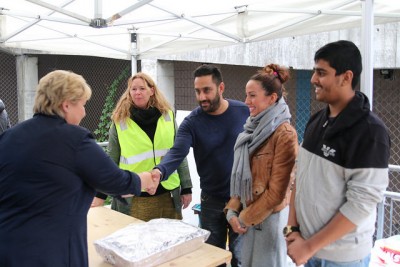Norway’s immigration agency UDI continued to desperately seek temporary homes for refugees over the weekend as the asylum seekers continued to stream into the country. Prime Minister Erna Solberg was set to address how her government would handle the refugee crisis, in a special address to Parliament on Tuesday.

There were no specific allocations made to fund refugee accommodation when the government’s state budget proposals were presented last week. Solberg and Finance Minister Siv Jensen said the government would present a separate plan, and funding proposals, at a later date. Now that’s expected this week, as UDI officials admit that capacity at all its asylum centers is at the bursting point.
“We are utterly dependent on getting help from the townships (kommuner), so that we can organize housing quickly,” Bjørn Fridfeldt, regional director for UDI in Finnmark, where refugees have been crossing the border into Norway from Russia. So far, the help isn’t coming quickly enough and several townships have refused to take in refugees, claiming they can’t afford to provide for them.
With refugee arrivals breaking all records in Norway, ordinary Norwegians have been coming forward and offering rooms in their homes. Over the past three weeks, more than 1,800 households have offered as many as 4,500 beds to refugees needing a place to stay. The offers are being registered through a new website set up to organize such voluntary civilian efforts, tilfluktshjem.no, but the numbers aren’t nearly enough to meet demand, with around 25,000 refugees now expected by the end of the year. They come on top of the more than 5,000 already-approved refugees who have been granted asylum and are still waiting in asylum centers for a place to live, plus the 8,000 refugees Norway has agreed to take in through the UN system.
In the far northern county of Finnmark, immigration officials have started using summer hotels that had closed for the season, while in the far south, officials are opening up a new reception center inside the former location of a large discount department store, Smart Club, that went out of business in Råde, between Sarpsborg and Moss. It can help register and house refugees entering Norway from Sweden through the main border station at Svinesund, but only on an extremely short-term basis of a few days at most. It’s intended to take the load off what had been the police department’s lone asylum registration center at Tøyen in Oslo, where hundreds of refugees were aided by volunteers who provided food, warm clothing and other items while the refugees waited ot be processed.

That voluntary effort was shutting down after seven weeks of the impromptu, grass-roots program called Refugees Welcome to Norway. Solberg visited both the volunteers and refugees last week before the registration program was moved to Råde, which is expected to be able to shelter as many as 1,000 refugees on bunk beds. All will also be given new and warm clothes, health checks and meals until space is found for them at asylum centers.
Humanitarian groups such as the Red Cross, Save the Children and Norwegian People’s Aid, accustomed to providing aid abroad, are now concentrating on the center within Norway’s own borders, at Råde, while also helping set up more accommodation capacity. The Refugees Welcome volunteers, still flush with donated clothing and household items for refugees, will also continue to meet “to plot the course further,” board member Line Baugstø told newspaper Aftenposten.
Thale Skybak of Save the Children (Redd Barna) told newspaper Dagsavisen she was impressed over how the authorities and organizations had managed to set up the center at Råde, inside the old Smart Club location just off the busy E6 highway. UDI is working together with the organizations to deal with the crisis, after nearly 5,000 refugees arrived in Norway last month alone.
Not all of them will automatically be granted permanent residence in Norway even if they’re granted asylum, though. In a controversial announcement last week, the justice ministry said it would instruct the UDI officials handling asylum applications to only grant residence permits for five years. State Secretary Jøran Kallmyr of the Progress Party, best known for being skeptical towards immigration, said the government wanted to maintain flexibility and be able to send refugees back to Syria, for example, if the civil war ends and they can safely return home.
It remains questionable what they would return to, given the massive destruction of homes and entire cities. Kallmyr nonetheless said that “most coming now will get temporary residence permits for five years,” after which their asylum status will be reevaluated. Around 75 percent of the refugees arriving are granted asylum, especially if they’re coming from war-torn Syria.
newsinenglish.no/Nina Berglund

